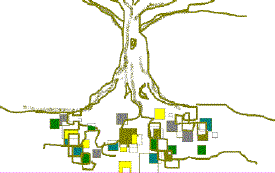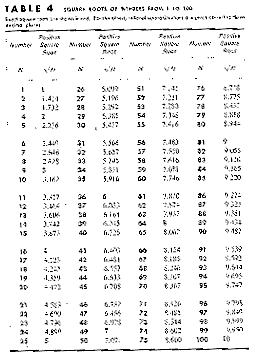Square Roots......An exercise in multiplication experimentation
|
| As you know, the area of a square is found by multiplying its
That is why they refer to n^2 (n to the second power) as "n squared". Now if we already KNOW the area of the square and we want to find the length of the sides, we are looking for the "SQUARE ROOT". EX: Let's say the area of this square
The funny black symbol is called the "radical sign" or square root symbol. *NOTE: (Every positive number has 2 square roots, a positive one and a negative one. When we are finding the sides of squares given their areas we only need the POSITIVE square root.) You try these. When you think you have the answer, run your mouse over the question to see if you are correct.
Now the tricky part comes when you have a square whose area is NOT a perfect square number. Let's say the square has an area of 39 square inches. How long would it's side be? Well it can't be 6, because 6x6 = 36 not 39. It can't even be 7, because 7x7 = 49 not 39. SO HERE IS WHERE WE START TO EXPERIMENT. FIRE up your CALCULATOR and let's get started! I think the square root will be closer to 6 so I will guess 6.3. Now we check it out. Use your calculator to multiply
6.3x6.3 , So now let's try 6.2 x 6.2 = 38.44....too small. Let's try 6.24 x 6.24 ...... that one gives 38.9376.....WOW we are getting close to 39 but still a bit too small. Let's try 6.25 x 6.25 ....... here we get 39.0625 ........just a hair too big. How about 6.248 x 6.248 = ...........39.037504 ........still too big. One more experiment, 6.247 x 6.247 = ........39.025009 Keep experimenting, see if you can get it down to three zeros after the decimal point. **In the old days, before
calculators, this is the way people found square roots by hand. They did tons of
experimenting, and as they found the roots out to the thousandths place value, they
created tables. These tables were put in the back of math books for the students to
use as reference. Now calculators can give you really good estimates of square roots. Some calculators can figure the values of square roots out to 10 decimal places. BUT IT IS STILL AN ESTIMATE of the real square root! Perfect square numbers like 1, 4, 9, 16, 25, 36, 49, 81, etc. have easy whole number square roots. But if we try to find the square roots of non perfect squares we will always get non repeating, non terminating decimals. For example: SQR(8) is approximately equal to 2.828427125... If you want to write the EXACT square root, you need to keep 8
under the radical symbol The radical symbol acts like a set of parentheses
when there is more than one number underneath it. If you
are asked to simplify the square root of 9 + 16,
"Squaring" a square root undoes the square root function.
NOW TO SOLVE AN EQUATION: Solve: Give the EXACT solution. 2 = d Here you multiply along the diagonals since you have a proportion. 2 x 13 = d x d 26 = d2 To undo the square on the variable we take the SQUARE ROOT of both sides. SQR(26) = SQR(d2) +/- SQR(26) = d Always remember there are two square root solutions, the positive and the negative.
|
Copyright © 1999-2020 themathlab.com  |

 Now since the length
and the width are the same in a square, you are really just multiplying a number by
itself to get the area of a square.
Now since the length
and the width are the same in a square, you are really just multiplying a number by
itself to get the area of a square.
